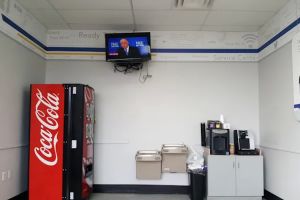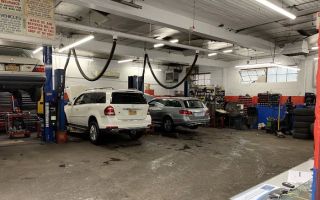How to Fix a Dead Car Battery on the Go
Getting a dead car battery while on the road can be a frustrating experience, especially when you’re far from home or in a rush. A dead battery doesn’t just disrupt your plans; it can leave you stranded in a vulnerable situation. But the good news is, there are ways to fix a dead car battery on the go and get yourself back on track without waiting for a tow truck. In this article, I will walk you through some practical steps to troubleshoot and fix a dead battery when you're stuck on the road. I’ll also provide tips on how to avoid the situation in the future, and when it’s time to call for professional help.

NTB-National Tire & Battery
6315 Prentiss School Dr, Canal Winchester, OH 43110, USA
1. Common Reasons for a Dead Battery
Before we jump into how to fix your dead car battery, it’s important to understand why it might have died in the first place. There are a few common causes for a dead car battery:
- Age of the Battery: Car batteries typically last 3-5 years. If your battery is older than that, it might be time for a replacement.
- Left the Lights On: One of the most common causes for a dead battery is accidentally leaving your headlights or interior lights on overnight.
- Corroded Battery Terminals: Corrosion around the battery terminals can prevent the car from starting, as it blocks the flow of electricity.
- Faulty Alternator: If your alternator isn’t working correctly, it won’t be able to charge your battery while the car is running, leading to a dead battery.
2. How to Fix a Dead Car Battery on the Go
If you’ve found yourself in a situation where your car battery has died while you're out and about, don’t panic. There are a few steps you can take to troubleshoot and even fix the issue temporarily until you can get professional help.

Pep Boys
1200 W Washington Blvd, Los Angeles, CA 90007, USA
2.1 Jumpstart Your Car
One of the quickest and easiest ways to get a dead battery working again is to jumpstart it. This is a simple process that requires jumper cables and another vehicle with a functioning battery. Here’s how you do it:
- Position the vehicles: Park the car with the good battery next to the car with the dead battery, ensuring the vehicles are close enough for the jumper cables to reach, but not touching.
- Turn off both vehicles: Make sure both vehicles are off before you begin the jumpstart process.
- Connect the cables: Attach one end of the red (positive) jumper cable to the positive terminal of the dead battery, then attach the other end to the positive terminal of the charged battery. Next, connect the black (negative) jumper cable to the negative terminal of the charged battery, and finally, attach the other end to a metal part of the car with the dead battery. Make sure the metal part is unpainted to ensure a good connection.
- Start the working vehicle: Start the car with the working battery and let it run for a few minutes to charge the dead battery.
- Attempt to start the dead car: After a few minutes, try starting the car with the dead battery. If it starts, remove the cables in reverse order.
2.2 Use a Portable Jump Starter
If you don’t have access to another vehicle, a portable jump starter is a great tool to have on hand. These devices are compact and can be used anywhere to jumpstart your car. Here's how to use a portable jump starter:
- Connect the jump starter: Attach the red (positive) clamp to the positive terminal of your dead battery, then attach the black (negative) clamp to a metal part of your car’s frame.
- Power on the jump starter: Turn on the jump starter and let it charge the battery for a few minutes.
- Start your car: After a few minutes of charging, attempt to start your car. If it starts, disconnect the clamps in reverse order.
2.3 Check the Battery and Terminals
If jumpstarting your car doesn’t work, the issue may be with the battery terminals. Over time, corrosion can build up around the battery’s positive and negative terminals, preventing proper contact. To clean the terminals:
- Turn off the car: Make sure your car is off and the keys are out of the ignition.
- Clean the terminals: Use a mixture of baking soda and water to clean off the corrosion. Apply the solution to the terminals, and scrub with a small brush.
- Reattach the battery cables: Once the corrosion is removed, reconnect the cables tightly to the terminals.
If this doesn’t fix the issue, there may be a deeper problem with your battery or charging system.
3. When to Call for Help
If you’ve tried jumpstarting and cleaning the terminals, but your car still won’t start, it’s time to seek professional help. A malfunctioning alternator, a deeply discharged battery, or other electrical issues could be the underlying cause. In these cases, it’s best to contact a towing or roadside assistance service.
Many times, a professional service like Rescue & Towing can come to your location and provide the assistance you need, whether it’s replacing a dead battery or towing your vehicle to a shop for further inspection.
4. Real-Life Story of a Jumpstart
Let me share a story. A few months ago, I was driving back from a road trip when I stopped for gas. I turned off my car, grabbed my things, and came back to find that my car wouldn’t start. The battery had died completely. Thankfully, I had a jump starter in my car and was able to fix the issue myself. After using the jump starter, my car started right up, and I was able to continue my trip without any problems. However, I kept the jump starter on hand for the rest of my journey, just in case something went wrong again!


























